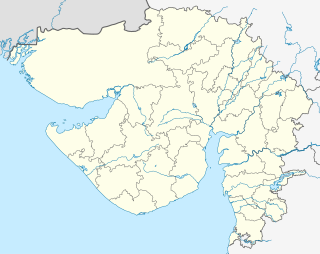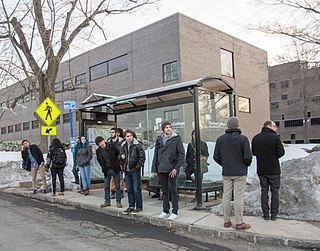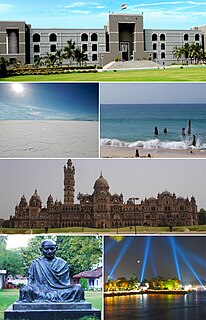Geography
Meghpur is located 18 km south from Bhuj, the neighbouring villages are Naranpur and Godpur. Meghpur is reached by State Highway 47 (Bhuj to Mandvi) and State Highway 48 (Bhuj to Mundra).

Bhuj is a Municipality and District Headquarter of Kutch District in the state of Gujarat, India.

Mandvi is a town with municipality in the Kutch district in the Indian state of Gujarat. It was once a major port of the region and summer retreat for Maharao (king) of the Cutch State. The old city was enclosed in the fort wall and remains of the fort wall can still be seen. The city has a four-hundred-year-old ship building industry, which was started by the caste of Kharva that still builds small wooden ships.

Mundra is a census town and a headquarter of Mundra Taluka of Kutch district in the Indian state of Gujarat. Founded about 1640s, the town was important mercantile centre and port throughout its history. Mundra Port is the largest private port in India.
As you turn into the road leading to the town from State Highway 47, you come across a garden created by the villagers with donations from overseas and the Gujarat Government. As you enter the village itself, you come to the Meghpur Primary school followed by the town center square (bhathaan). The bus stop is located in the square were there are shops, tea stalls and Shankar Mandir (Temple).

The Government of Gujarat, also known as the State Government of Gujarat, or locally as State Government, is the supreme governing authority of the Indian state of Gujarat and its 33 districts. It consists of an executive, led by the Governor of Gujarat, a judiciary and a legislative branch.

A bus stop is a designated place where buses stop for passengers to board or alight from a bus. The construction of bus stops tends to reflect the level of usage, where stops at busy locations may have shelters, seating, and possibly electronic passenger information systems; less busy stops may use a simple pole and flag to mark the location. Bus stops are, in some locations, clustered together into transport hubs allowing interchange between routes from nearby stops and with other public transport modes to maximise convenience.

A temple is a structure reserved for religious or spiritual rituals and activities such as prayer and sacrifice. It is typically used for such buildings belonging to all faiths where a more specific term such as church, mosque or synagogue is not generally used in English. These include Hinduism, Buddhism, and Jainism among religions with many modern followers, as well as other ancient religions such as Ancient Egyptian religion.
There is a river alongside the old and new Meghpur and with the partnership of the Indian Government and the private sector 9 check dams have been built to converse water. The village enjoys a constant water supply with the old well and main supply tanks located behind the primary school. The new borehole has had to be located 3 km on the other side of the river due to the reduction in water following the 2001 Gujarat earthquake that struck the region with frightening accuracy.

The 2001 Gujarat earthquake, also known as the Bhuj earthquake, occurred on 26 January, India's 52nd Republic Day, at 08:46 AM IST and lasted for over 2 minutes. The epicentre was about 9 km south-southwest of the village of Chobari in Bhachau Taluka of Kutch District of Gujarat, India.
Meghpur was not harshly affected by the 2001 Gujarat earthquake that had caused severe damage in the region.
People
The main religion of the villagers is Hinduism who follow the Swaminarayan Sampraday philosophy.
Meghpur is inhabited by various groups and communities. Many of these have reached this region after centuries of migration from neighbouring regions of Marwar (Western Rajasthan), Sindh, Afghanistan and further.
Majority of the inhabitants are Leva Patel, Rabaris , Meghvals,Muslim,goswami . There are almost no houses of original founders, the Mistri community in the village.
Leva Patel
The Leva Patel group of Kanbi's have 24 Ghams (villages) in Kutch. The Leva Patel community migrated out of Meghpur in the 1970s and came to England; many Meghpurians have settled down in Wembley, Kensal Rise, Harlesden, Kingsbury, Harrow, Edgware, Kenton, Queensbury and Cardiff. The Leva Patel's are commonly referred to as 'Kutchi' as a community, this is a misconception because the Kutchi people are a complete different community with a their own Kutchi language.
The Leva Patel community has formed a huge active society: Shree Kutch Leval Patel Community SKLPC
A number of Meghpurians migrated to Africa, especially Kenya, Uganda and Tanzania in the early 1960s. Today Meghpurians can be found in the United States and as far as Australia.
The Halai, Vaghjiani and Hirani clans make up the majority of Leva Patel families in Meghpur.
Food
The staple food is Rotlas made of Bajri (millet) which the local relish with butter milk or 'chhas', butter and jaggery or 'gud'.'khichhdi' made of rice and dal (pulses) is liked by everyone.
The usual cuisine consists of roti or rotlas, curd, butter milk, dal, curry, vegetables, papad, kachumbar. Dry rotlis or theplas and khakras and sev (of gram flour) are made and stored as food during travelling etc.
Nowadays, food values are becoming more tasty and palatable than nutritious. The main delicacies in food items are Dhokla, Gathia, Undhia, Muthia, Raita, Dahi Wada, Kachori, Bhajia, Bhaji made of brinjal and lady's finger as a change from normal food, Dabeli, Puri Shak, Pav Bhaji and Papdi.
There are many varieties of sweets like Mohanthal, Pendas, Halwa, Gulab Jamun and Jalebi. Seeds of Dhaniya or Dhana dal, Betal Leaf or Paan with Supari is eaten after food as the last item.
Tea which was unknown 60 years ago has become the universal drink among all classes of people (reference required). Often villagers are seen late afternoon drinking tea and socialising in the main square (bhathaan).

Kutch district is a district of Gujarat state in western India. Covering an area of 45,674 km², it is the largest district of India. The population of Kutch is about 2,092,000. It has 10 Talukas, 939 villages and 6 Municipalities. The Kutch district is home to the Kutchi people who speak the Kutchi language.
Kutchi is an Indo-Aryan language spoken in the Kutch region of India. The name of the language is also transliterated as Kutchhi, Kachchi, Kachchhi, Kachhi or Cutchi.

Bharasar is a small village in the Kutch District of Gujarat, India.

Samatra is a small village located in the Kutch district of Gujarat state, India. The first settlement was established by two Varsani brothers by the names of Velji Bapa and Manji Bapa. From this other families, such as, the Gami, Pindoria, Hirani, Bhanderi, Kerai and Bhudiya families, gradually joined in and strengthened and united the community as a whole. However, this is not the earliest known Varsani history. In 1386, in a small village called Savalia, it is acknowledged that Varsanis once lived here before travelling and inhabiting several other small villages until finally settling down.

Kodki is a village, located 11 km west of Bhuj, in Kachchh District in the state of Gujarat, India. It is one of 24 gramas (villages) occupied by the Shree Kutch Leva Patel Community (SKPLC).

Dhaneti or Dhanetee is a village in Bhuj Taluka of Kutch District of Gujarat State of India. It is at a distance of about 26 km from Bhuj the Taluka and district headquarters of Kutch. Although it is in Bhuj Taluka, the Anjar Taluka headquarters of Anjar is only 18 km away.
Kutch Gurjar Kshatriya are a minority Hindu and one of the Socially and Educationally backward community of Gujarat in India, whom claim to be Kshatriyas. They are an artisan community related with Kadia works.They are also known as the Mistri a.k.a. Mistris of Kutch.
The Halaypotra are a Muslim community found in the state of Gujarat in India and a province of Sindh in Pakistan. They are one of a number of communities of Maldhari pastoral nomads found in the Banni region of Kutch.
The Hingora are a Muslim community found in the state of Gujarat in India and a province of Sindh in Pakistan. They are one of a number of communities of Maldhari pastoral nomads found in the Banni region of Kutch.
The Hingorja are a Sindhi Muslim community found in the state of a province of Sindh in Pakistan. They are one of a number of communities of pastoral nomads found in the Banni region of Kutch.
The Ker are a Muslim Rajput community found in the state of Gujarat in India and a province of Sindh in Pakistan. They are one of a number of communities of pastoral nomads found in the Banni region of Kutch.
The Shaikh are a Muslim community found in the state of Gujarat in India. They are part of the larger Shaikh community of South Asia. Included within the Shaikh community are the Shaikhda of Bharuch district and the Sodagar of Patan.
The Rahuma and also known as (Sindhi: راهمون Rahimoon) are a Muslim community found in the state of Chohatan Sedwa Shiv Gadrarod Ramsar Taluka in Barmer Rajasthan Gujarat in India and a province of Umarkot Chachro Tharparkar Sindh in Pakistan. They are one of a number of communities of pastoral nomads found in the Banni region of Kutch. The community is also known as Rahuma, especially in Sindh.
The Meta Qureshi are a Muslim community found in the state of Gujarat in India and a province of Sindh in Pakistan. They are one of a number of communities of pastoral nomads found in the Banni region of Kutch. The community is also known as simply Qureshi.
The Bafan are a Muslim community found in the state of Gujarat in India and a province of Sindh in Pakistan. They are one of a number of communities of Maldhari pastoral nomads found in the Banni region of Kutch.
The Chakee are a Muslim community found in the state of Gujarat in India. A small number are also found in the city of Karachi in Pakistan.

Kutch Museum in Bhuj is the oldest museum of Gujarat. It is located opposite Hamirsar Lake in Bhuj, Kutch, Gujarat, India.

Vandhay or Vandhai is a village in Bhuj Taluka of Kutch District of Gujarat. It is 59.6 km from Bhuj, district and taluka headquarters.
The Waryah are a Muslim community largely found in the Sindh region of Pakistan and in the state of Gujarat in India. They are mostly located in Banni, Mandvi, Bhuj, Mundra region of Kutch, India and Tando Adam Khan, Sanghar, Sanghar District, Bachal Varya, Karachi province of Sindh and Dera Ghazi Khan District.
Mahendra Varsani is an Indian producer, director and screenwriter of Gujarati-Hindi films, best known for the film Neelkanth (film) (2012).
This page is based on this
Wikipedia article Text is available under the
CC BY-SA 4.0 license; additional terms may apply.
Images, videos and audio are available under their respective licenses.













